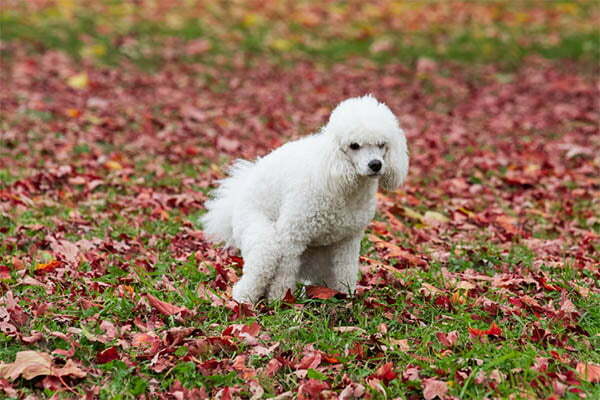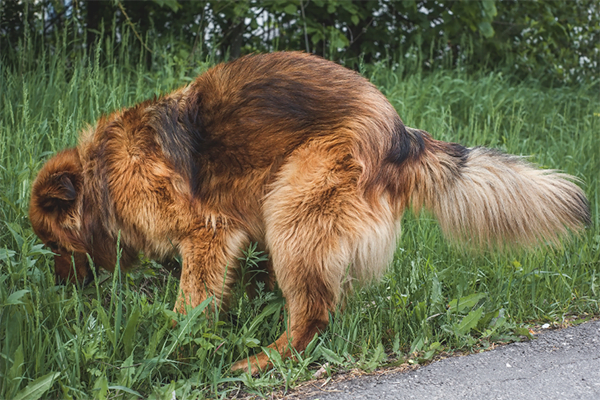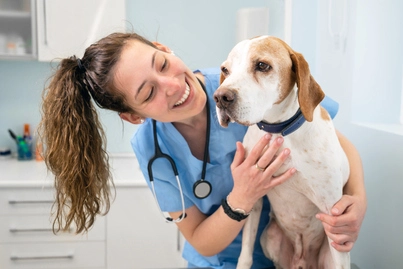Changes in stool and urine can be great indicators of what is happening in your dog’s body. It can tell you if your dog is feeling constipated or even if they are nervous!

But if you go to pick up your dog’s poop and see red, that can be really worrying. Sometimes you might even notice yellow mucus or even white dots!
Finding Yellows, Reds, or Whites in your dog’s poop feels very unnatural.
As someone who has seen this unsettling mucus in my and other dogs’ poops, I have had to speak with vets about this very situation. Let me tell you what’s going on in your dog’s body, and how you can help.
Why Is There Jelly Substances or Mucus in Dog Poop?
The first thing you need to know is that mucus in dog stool is very common and even necessary. Only on some occasions will the sight of jelly or mucus mean going to see the veterinarian.
Mucus is a slime or jelly-like substance, and it is made by the intestines in your dog’s body. The mucus is there to keep the colon’s lining lubricated and healthy.
Without it, your dog will have a hard time pooping and will be in a lot of pain, essentially, they will become constipated. Finding a small amount of mucus in your dog’s poop is normal, as it likely stuck to the feces on the way out of your dog’s body.
But what is a small amount? A small amount of mucus is often undetectable and is usually inside the poop itself.
If you are noticing the jelly-like substance, then there is probably a large amount of mucus in the stool. This could mean that something is wrong with your pooch.
Depending on what this mucus looks like, and how much of it there is, there would be different reasons as to why your dog’s body is producing so much!
Being a good dog parent means knowing when there are changes in your dog’s habits, so even if you don’t see a lot of mucus now, keep your dog’s health in mind when you are scooping their poop.
Connect with a verified veterinarian in minutes. No waiting for appointments or office hours. No high fees. Your pet's health made convenient and worry-free.
My Dog is Only Pooping Mucus!
If your dog is only producing the jelly-like substance which is mucus, and hardly any poop is coming out, then this means something is wrong with their body.
You might notice your dog is overly straining as they try to poop, and the jelly substance is all they can make.
The problem here is in your dog’s GI tract. A GI tract is a gastrointestinal tract, and it contains the mouth, stomach, small intestine, large intestine, and anus.
It is a big system within the body, but the likelihood is that there is a problem with inflammation somewhere along the GI tract.
Your dog’s own body should be able to soothe itself and resolve the inflammation, but if your dog is pooping only mucus for over 24 hours, then you should call your vet.
This is because the cell turnover in your pooches’ gut is so rapid that the issue that caused the overly mucousy stool should have been shed when the mucus was created.
If, after 24 hours, the mucus is still there, that means the body can’t deal with the problem as easily as it should.
My Dog is Pooping Red Jelly!
If your dog’s stool is loose and has jelly-like blood, this is probably an indication that your dog has colitis, also known as HGE (Hemorrhagic Gastroenteritis).
Colitis is caused by many things, including stress, infections, parasites, allergic reaction, and inflammation in your dog’s bowel. The most common cause is inflammatory bowel disease, also known as IBD.
If you think that your dog has inflammatory bowel disease, but you’re not sure, the other signs of the disease are frequent vomiting, loss of appetite, weight loss, and pooping more often than normal.
Whatever causes the colitis, the inflammation in your pooches’ colon has a knock-on effect on the water absorption in their body. It reduces the amount of water that can be absorbed and also stops your dog from being able to store feces in their colon.
That is why your dog may have loose stools and need to poop more often than normal.
Because of the strain, this will put on your dog, the feces are often layered in mucus and blood.
If you find red jelly, mucus, or blood in your dog’s stool, you should go to the vet because these problems, if left untreated, can cause mild to life-threatening domino effects on your dog’s health.
Dogs with this condition become very ill, very quickly. They can look perfectly normal and happy one day and act strange or become violently ill the next.
Most dogs will recover after a few days of vet treatment, but to ensure that treatment doesn’t come too late and permanently affect your buddy’s health, you need to see a vet as soon as possible.
An untreated dog experiencing colitis symptoms can quickly go into hypovolemic shock because of the inability to absorb water correctly. Hypovolemic shock is a deadly condition, if your dog is suffering from it, they will become agitated and confused. They will be weak and find it hard to stand, and they will likely start panting.
Thankfully, the survival rate is high as long as your dog gets the necessary treatment!
My Dog is Pooping Yellow Mucus!
If you have noticed that your dog is experiencing bouts of diarrhea, won’t stop farting, and they have grown cranky and irritated, then there is something wrong with your pooches’ health.
Yellow mucus in your dog’s stool is likely to be a sign that the natural intestinal bacteria in their body has overgrown like grass through the cracks in a patio. This happens if your dog is unable to digest food because of an intolerance.
The bacteria in your buddy’s small intestine are needed to produce vitamins and protect from diseases.
The bacteria use the food around it to fuel these healthy actions, but if your dog can’t digest some of the food left in the small intestine, then the bacteria will use those leftovers to keep feeding itself instead.
This condition happens a lot with dogs who have exocrine pancreatic insufficiency, and German Shepherds are the most likely dog bred to be suffering from this.
So now you know why your dog has yellow mucus in their stool, you need to know how to help them get better.
Yellow Mucus is due to food intolerance, so if you have recently changed your dog’s diet, have a look at the new ingredients that they have used in comparison to your buddy’s old diet.
These are the ingredients that you should now try to avoid.
To calm your dog’s intestines whilst they try to rebalance, you should give your dog probiotics. It might sound silly to add more bacteria into your dog’s already overly bacterial intestines, but the probiotics will help bring balance back to their body.
What Are the White Specks in My Dog’s Poop?

In general, there are three reasons why there are white specks in your dog’s feces. It is either undigested food like rice, flies that have nested in your dog’s poop, or your dog has worms! The only way to find out is by taking a closer look.
This isn’t the nicest topic, and your stomach might churn thinking about it, but to see what’s going on in your dog’s health, you’re going to need to dig around their feces. I mean this metaphorically, though!
You don’t necessarily need to get your rubber gloves on because if you get close enough, you should be able to see the white specks in enough detail to understand what they are.
So now your head is inches from feces; what are you looking for?
Movement
Watch for a moment and look out for movement. If those white specks start to riggle, then what you are probably looking at are roundworms.
They are a type of parasite that lives in your dog’s intestines, and they feed on partly digested food. You are most likely to find worms in puppies, but adult dogs can get them too.
Horribly enough, people can get worms as well. They are normally white or light brown and can grow a couple of inches long.
If your dog has roundworms, they are probably also in some kind of belly pain; they might have a bloated tummy and could be experiencing vomiting and diarrhea.
If you think your pooch has worms, then take them to the vet. They can check your dog’s poop and confirm if those white specks are roundworms or even if they are roundworm eggs. Your vet will give your buddy a treatment to kill off the worms in three doses.
Texture
You know I said that you don’t need to put on any rubber gloves? Well, sorry to say it, but now you do, because the next thing you need to look for is the texture of the white dots!
What we are looking for is the hard and smooth texture of bone or the soft and squishy texture of rice or other grains.
If you find what seems to be small pieces of bone, then what may have happened is that your dog didn’t properly digest their food.
In all food products made for dogs, no matter the brand, there will be a possibility of small bone pieces in the mixture. This normally isn’t something to worry about because the pieces won’t be big, and your dog can pass them.
If the idea upsets you though, then you can buy vegan-based dog foods instead. Before you make a complete switch, test the new diet slowly on your dog to see if they are happy with your choice.
A more common reason for the still white specks is the presence of grains in your dog’s food. Dogs find grains and rice difficult to digest, but they tend to be a common ingredient to bulk up cheap dog food.
If the white speck feels soft and squishy, like a cooked grain of rice, then you have found the issue. The way to fix this problem is simple, look out for grains and rice in your dog food ingredient list and avoid buying those packets when you notice they are there.
Clumped together or Lots of them?
The last thing you should now be looking for is what these white specks look like. Are they clumped together, or are they scattered about?
If the specks are scattered about in your dog’s poop, are they loads of them? If the answer to these questions is yes, then what you might be looking at are fly eggs.
Flies will lay eggs in your dog’s poop if it has been left outside for a long time. This isn’t an immediate problem for your dog’s health, but if you leave poop outside for too long, you can contaminate your garden, killing off your grass and plants.
You might think that dog poop is natural and so will decompose, and that is true, but it will take a long time and will attract all kinds of bugs in the process.
Decomposition involves lava, flies, and microbes. Although this is all-natural, so are the diseases that they carry.
Leaving your dog’s poop outside leaves both you and your dog open to these diseases, so make sure you pick up the poop as soon as you can.
Conclusion
So now you know what those strange colors in your dog’s poop mean and what you should do about it! Remember to regularly check your dog’s poop and keep an eye out for any changes in their behavior.
If you are ever unsure, head to the vets, and they can give you personalized advice for your buddy.

